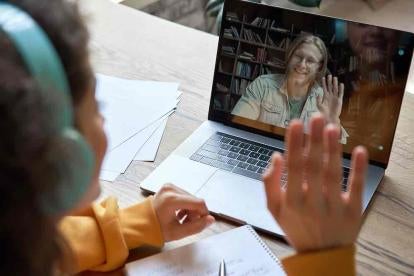The first full school year conducted during the Covid-19 pandemic is coming to a close.
The sudden inability to deliver educational instruction in person due to the pandemic gave rise, by necessity, to the expanded use of third-party content (think YouTube and Ted Talks) and the technology to deliver it (think FlipGrid, Quizlet, and Zoom).
While these tools are not new, it is the enhanced role of professors in harnessing the resources together to create a “package” of instructional content made up of combinations of lectures, images, videos, online demonstrations, and even experiments, that is causing the IP conventions in academia to begin to shift.
What Does Copyright Law Protect?
For copyright protection to arise, original works must be reduced to a tangible medium of expression – recorded for posterity, so to speak. A professor’s words merely spoken in a classroom setting do not qualify. In contrast, most content prepared for online learning was either recorded ahead of time (aka asynchronous learning content) or recorded as delivered (with or without permission) in real time at the time delivered, often for later access.
Who Owns Original Virtual Content?
While the scramble to deliver high-quality content for learners took the front seat to legal analysis this past year, now that the dust has settled, how will institutions of higher education treat virtual content packaged for delivery to students via its virtual classrooms?
Typically, those who create original works of authorship, including audiovisual content, visual arts, or music, own those works the moment they are created, regardless of payment or instruction. An exception to this is when such work is created within the scope of employment. In this case, the work belongs to the employer. In the world of academia there has been a long-standing tradition of treating scholarly works created by professors, even with the traditional “scope of employment” indicia, as the intellectual property of professors. Explanations are speculative, perhaps among them are the tangible and intangible benefits to both professors and universities from acclaimed works of authorship being associated with the universities, and the need to incentivize professors to remain prolific in their fields of instruction.
However, as the value of high-quality packaged instructional content increases and the sophistication of those creating it improves, it may be more difficult for universities to refrain from defaulting to the “general” rule of university-as-owner. Moreover, the temptation to use third-party content (copying Instagram content is not fair use) in developing materials raises the risks to universities.
Risks and benefits of organizational practices should be considered in addressing the new IP challenges faced by schools and universities.
How Can Academic Institutions Reduce IP Related Legal Risks? Ask Yourself the Following Questions:
-
Does your school or university have a policy that delineates ownership of original works created for classroom instruction?
-
Does the policy permit use of content by non-owners through license, even on a royalty-free, perpetual basis?
-
Has your institution adopted or expanded an existing policy regarding the unauthorized use of third-party materials video, audio, or other content in the context of “university” instructional materials that might help insulate the university from unauthorized copying (copyright infringement)?
-
Does your institution maintain contracts with its instructors that address policies of using school-owned resources for personal work?
-
Has your school secured a release from each instructor of rights in his or her likeness for use in connection with further distribution of instructional content?
-
Does your institution review online course materials before they are distributed and broadcast to learners or others? Does it maintain a central repository for such materials?
-
Has your school considered a system for incentivizing instructors to “do more” with online content for further use by the university with future students or populations that may not be enrolled?
-
Is there a method for identifying valuable, instructional materials and registering those with the U.S. Copyright Office as warranted?




 i
i


